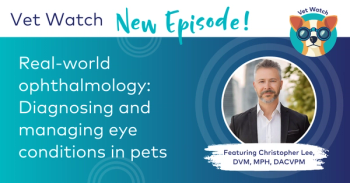
Genetic ocular problems: what breeders know that you need to know (Proceedings)
Most conditions in ophthalmology have a strong connection to genetics. Often a diagnosis can be made by knowing only the breed, age, and presenting complaint. There are some conditions that are common to one breed but rarely if ever seen in another. This review will list the most notable genetic conditions for each region of the eye.
Most conditions in ophthalmology have a strong connection to genetics. Often a diagnosis can be made by knowing only the breed, age, and presenting complaint. There are some conditions that are common to one breed but rarely if ever seen in another. This review will list the most notable genetic conditions for each region of the eye.
Eyelid
Entropion:
Inversion of the eyelid margin such that the eyelid cilia contact the cornea causing irritation.
Chow Chow, Shar Pei, Cocker Spaniel, Retrievers, Poodles
Ectropion:
Eversion of the eyelid such that the margin does not contact the cornea. Giant breeds.
St. Bernard, Bloodhound, Great Dane, Newfoundland, Bull Mastiff
Distichiasis:
Cilia emerging from the Meibomian gland duct openings. Often fine hairs that cause no clinical problems
Cocker Spaniel, Miniature Dachshund, Bulldog, Yorkshire Terrier
Trichiasis:
Normal eyelid cilia that are deviated abnormally toward the cornea
Cocker Spaniel, Shi Tzu, Japanese Chin
Globe and surrounding tissues
Microphthalmia:
Globe of an abnormally small size. Often they are still visual, but may be associated with other congenital anomalies.
Australian Shepherd, Collie, Miniature Schnauzer, Shetland Sheepdog
Dermoid:
Ectopic patch of haired skin growing on the cornea or conjunctiva. Although it looks unusual, it poses no health risk, is non-progressive, and is easily treatable with surgery.
Dachshunds, Doberman Pincer, Dalmatian, St. Bernard, German Shepherd
Cherry Eye:
Prolapse of the third eyelid gland due to abnormal connective tissue attachments. Non-painful and can lead to dry eye if the gland is not replaced.
Bulldog, Cocker Spaniel, Neapolitan Mastiff
Cornea and sclera
Corneal Dystrophy:
White cholesterol or calcium deposits in the cornea. Typically cause no pain or vision loss. Treatment is usually not needed.
Siberian Husky, Shetland Sheepdog, Beagle, Collie, Cavalier King Charles
Corneal Endothelial Dystrophy:
Progressive blue corneal edema resulting from loss of corneal endothelial cells. The corneas appear blue, but there is no pain and vision is unaffected except for severe cases.
Boston Terrier, Longhaired Dachshund, Chihuahua, Chow Chow
Microcornea:
Normal globe size but abnormally small cornea.
Australian Shepherd, Miniature Schnauzer, Miniature and Toy Poodle, St. Bernard
Non-Healing Ulcers:
Condition affecting the ability of corneal epithelial cells to attach to the underlying stroma. Typically occur spontaneously and rarely seen in dogs less than 7 years of age.
Boxer, Retrievers, Samoyed, Poodles
Pannus:
Autoimmune condition involving abnormal vascularization and pigmentation of the cornea.
German Shepherd, Greyhound, Australian Shepherd, Cattle Dogs, Siberian Husky
Iris and uvea
Persistent Pupillary Membranes:
Remnant of the vascular network that surrounded the developing lens in utero. They can extend from the iris to another location on the iris, the cornea, or the lens.
Basenji, Chow Chow, Miniature Schnauzer, Mastiff, Corgi
Iris Coloboma:
Defect in the iris caused by incomplete fusion of embryonic tissues.
Australian Shepherd, Collie, Shetland Sheepdog
Uveitis:
Inflammation of the uveal tract which typically causes photophobia, cloudy appearance, and injected sclera. This can lead to loss of vision and glaucoma. Most cases are not hereditary.
Miniature Schnauzers (familial hyperlipidemia), Golden Retriever (Pigmentary Uveitis), Cairn Terrier (Pigmentary Glaucoma Syndrome)
Lens
Cataract:
Opacity of the lens which often results in vision impairment. Many affected breeds.
Miniature Schnauzer, Boston Terrier, Golden Retriever, Chow Chow, American Cocker Spaniel, Welsh Springer Spaniel, West Highland White Terrier, Standard Poodle, Bichon Frise, Siberian Husky, Havanese...
Luxation:
Progressive degeneration of the lens zonules which keep the lens suspended in place. The final result is a freely movable lens within the eye.
Terriers, Shar Pei, Border Collie
Microphakia:
Abnormally small lens
Lens coloboma:
Flattened edge of the lens, typically due to incomplete zonule attachment
Retina
Dysplasia:
Area of improperly formed retina. It can be minor with no effect on vision or severe and blinding.
Cavalier King Charles, Springer Spaniel, Labrador Retriever
Coloboma, Choroid Hypoplasia:
Incomplete formation of one or multiple layers of the choroid and sclera. The overlying retina may or may not be affected. It is often seen as a component of Collie Eye Anomaly and Merle Ocular Dysgenesis.
Collie, Shetland Sheepdog, Australian Shepherd, Border Collie
Detachment:
Spontaneous tear and progressive disassociation between the retina and the underlying choroid.
Shih Tzu, Labrador Retriever
Progressive Retinal Atrophy:
Progressive loss of retinal cells. It usually begins early in life and causes complete vision loss by mid-life. Poor vision in dim light is usually the first noticeable sign.
Miniature Schnauzer, Miniature and Toy Poodle, Labrador Retriever, Cocker Spaniel, Norwegian Elkhound, Collie
Glaucoma
Glaucoma is elevated intraocular pressure caused by progressive decrease in the ability of aqueous humor to escape the eye. Congenital glaucoma in puppies is rarely seen. Most hereditary primary glaucoma affects dogs very rapidly between ages 4-7. Many breeds are susceptible.
Bassett Hound, Cocker Spaniel, Chow Chow, Shar Pei, Siberian Husky, Beagle, Norwegian Elkhound
Secondary Glaucoma:
Elevated intraocular pressure due to another ongoing condition and unrelated to the anatomy of the aqueous outflow path. Any breed is susceptible. Common causes include uveitis, lens luxation, neoplasia, retinal detachment, and trauma.
Newsletter
From exam room tips to practice management insights, get trusted veterinary news delivered straight to your inbox—subscribe to dvm360.






